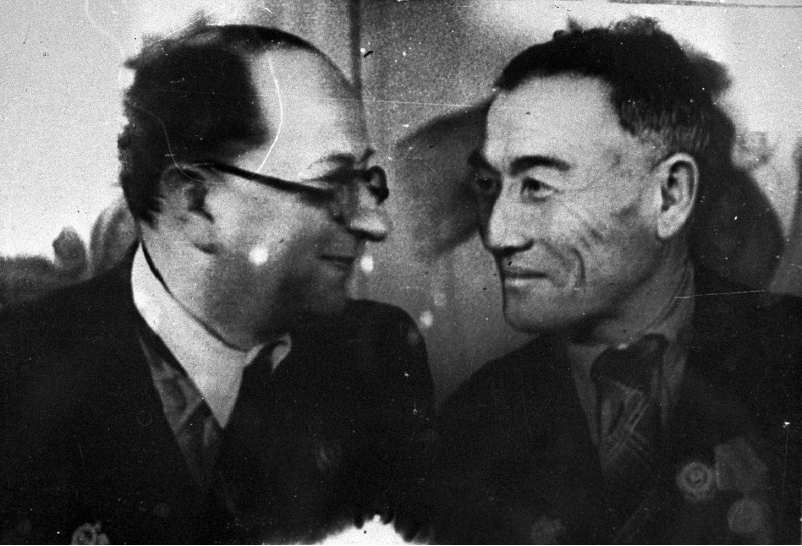The birth of cinema in Kazakhstan
The history of Kazakh cinema began in the 20s of the last century. Films directed by Sergei Eisenstein, Vsevolod Pudovkin, Alexander Dovzhenko and other Soviet cinematographers had a great influence on the birth of cinema in Kazakhstan
In 1929, the first film studio was established in Alma-Ata, which was the production department of the Vostokkino Trust.
In 1934, the Alma-Ata Newsreel Studio was established. In 1936, documentaries began to be produced on it. In 1938, the first Kazakh feature film "Amangeldy" was shot at the Lenfilm film studio.

A shot from the 1938 film "Amangeldy".
On September 12, 1941, on the basis of the Resolution of the Council of People's Commissars of the Kazakh SSR No. 762, the Alma-Ata Film Studio (feature films) was established.

Kinopavillon, Almaty, 1941
On November 15, 1941, the Alma-Ata Film Studio merged with the Mosfilm and Lenfilm studios evacuated to Kazakhstan into the Central United Feature Film Studio (TSOKS), which operated until 1944 and produced 80% of all domestic feature films shot during the war years.

Director Grigory Roshal with actor Yelubai Umirzakov, 1944.
On January 25, 1944, the Alma-Ata Film Studio was renamed the Alma-Ata Film Studio of Feature and Chronicle Films.
On January 9, 1960, by order of the Ministry of Culture of the Kazakh SSR, the Alma-Ata Film Studio of Feature and Chronicle films was renamed the Kazakhfilm Film Studio.
In 1984, the film studio was named after the figure of national cinematography Shaken Aimanov.

Directed by Sh. Aimanov. The working moments of filming.
In 1985, the film studio was transformed into the Republican Creative Production Association - RTPO Kazakhfilm named after Sh. Aimanov.
On August 20, 1996, RTPO Kazakhfilm named after Sh. Aimanov was reorganized by dividing into the Kazakh Film Factory named after Sh. Aimanov (material and technical base) and the National Production Center of the Republic of Kazakhstan (organization of the creative process, work with independent production studios).

The mounting apparatus from the Sh Museum.Aimanova
According to the order of the Minister of Culture and Information of the Republic of Kazakhstan dated 31.10.2023, Kazakhfilm JSC named after Shaken Aimanov" was renamed into JSC "Kazakhfilm National Film Studio named after Shaken Aimanov" (hereinafter referred to as the Film Studio).
The first film directors and the first pictures
The history of the national cinema is full of interesting events, some of which have radically changed the course of its development. Changes were brought about both by economic shocks, for example, the collapse of the USSR, and cultural ones. The release of innovative films influenced the development of an entire genre. So, after S.Khodzhikov's film "Kyz Zhibek", the concept of a folklore film was no longer perceived as something formulaic. The chronicle of Kazakh cinema, like any story, was changed by people.

Director Sultan-Akhmet Khodzhikov on the set of his cult film "Kyz-Zhibek"
In 1929, the first film studio was established in Alma-Ata, which was the production department of the Vostokkino Trust.
Chronicle newsreels under the general title "Latest News" (films "Zhailau", "Turksib") were filmed here.
In 1934, the Alma Ata Newsreel Studio was opened: the production of documentaries for the Soviet Kazakhstan newsreel began (films "The Ray of the East Collective Farm", "The Defeated Desert", "Mangyshlak Peninsula").
The founder of Kazakh documentary cinema, Oraz Abishev, has released about 70 documentaries ("The City of Miners", "Dina Nurpeisova", "On Distant Pastures", "A Sign on a Stone") and 300 newsreels. Oraz Abishev's work is characterized by a true depiction of the traditions and way of life of the people.
In 1938, the feature film "Amangeldy" was shot in the genre of heroic epic, with Vsevolod Ivanov, Beyimbet Mailin and Gabit Musrepov working on the script. The role of the famous batyr was played by Yelubai Umurzakov.
During the Great Patriotic War, the Central United Film Studio (TSOKS), created from the Alma Ata Film Studio and the evacuated Mosfilm and Lenfilm, worked in Alma-Ata.
From 1941 to 1945, the CSC produced 80% of all domestic film production. At that time, outstanding cinematographers worked here: S.Eisenstein, M. Romm, I.Pyriev, V.Pudovkin, G.Roshal, D.Vertov, the Vasilyev brothers and many others. During the war years and the VGIK (All-Union State Institute of Cinematography) He was evacuated to Alma-Ata, which became a wonderful opportunity for Kazakhstanis to receive professional film education from the best masters of cinema.
The Golden Age of Kazakh cinema (60s) is associated with the names of outstanding domestic cinematographers: Sh.Aimanov, M.Begalin, S.Khodzhikov, A.Karsakbayev. Within the strict framework of Soviet censorship, it was these directors who shot paintings that reflected the life and way of life of the Kazakh people in various genres ("Poem about Love", "Our dear Doctor", "Land of the Fathers", "Angel in a skullcap" Sh.Aimanova, "Traces go beyond the horizon", "The Song of Manshuk" by M.Begalin, "Kyz Zhibek" by S.Khodzhikov, children's films "My name is Leather", "Alpamys goes to school" by A.Karsakbayev). Gradually, a gallery of beautiful film images is being created, recreated by wonderful actors Yelubai Umurzakov, Kapan Badyrov, Seraly Kozhamkulov, Amina Umurzakova, Nurmukhan Zhanturin, Farida Sharipova, Idris Nogaibaev, Gulfairus Ismailova, Lola Abdukarimova, Asanali Ashimov, Nurzhuman Ytymbaev, Meruert Utekesheva, Anuar Moldabekov, etc.

A shot from the musical comedy "Angel in a skullcap" 1968 directed by Sh. Aimanov (actors Alimgazy Rayymbekov and Amina Umurzakova)
On January 9, 1960, by order of the Ministry of Culture of the Kazakh SSR, the Alma-Ata Film Studio of feature and Chronicle films was renamed the Kazakhfilm Film Studio. By this time, the studio regularly produces feature films.

In 1967, the founder of Kazakh animation, Amen Khaidarov, shot the first Kazakh animated film "Why does a swallow have a tail with horns?", which was awarded prizes at the III All-Union Film Festival (1768) and the III New York Animated Film Festival (1974).




